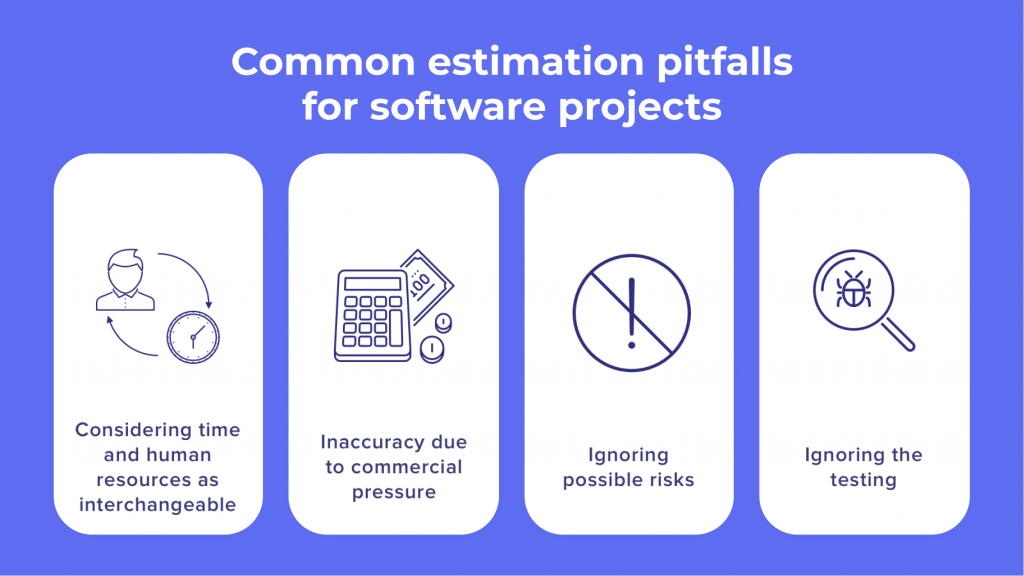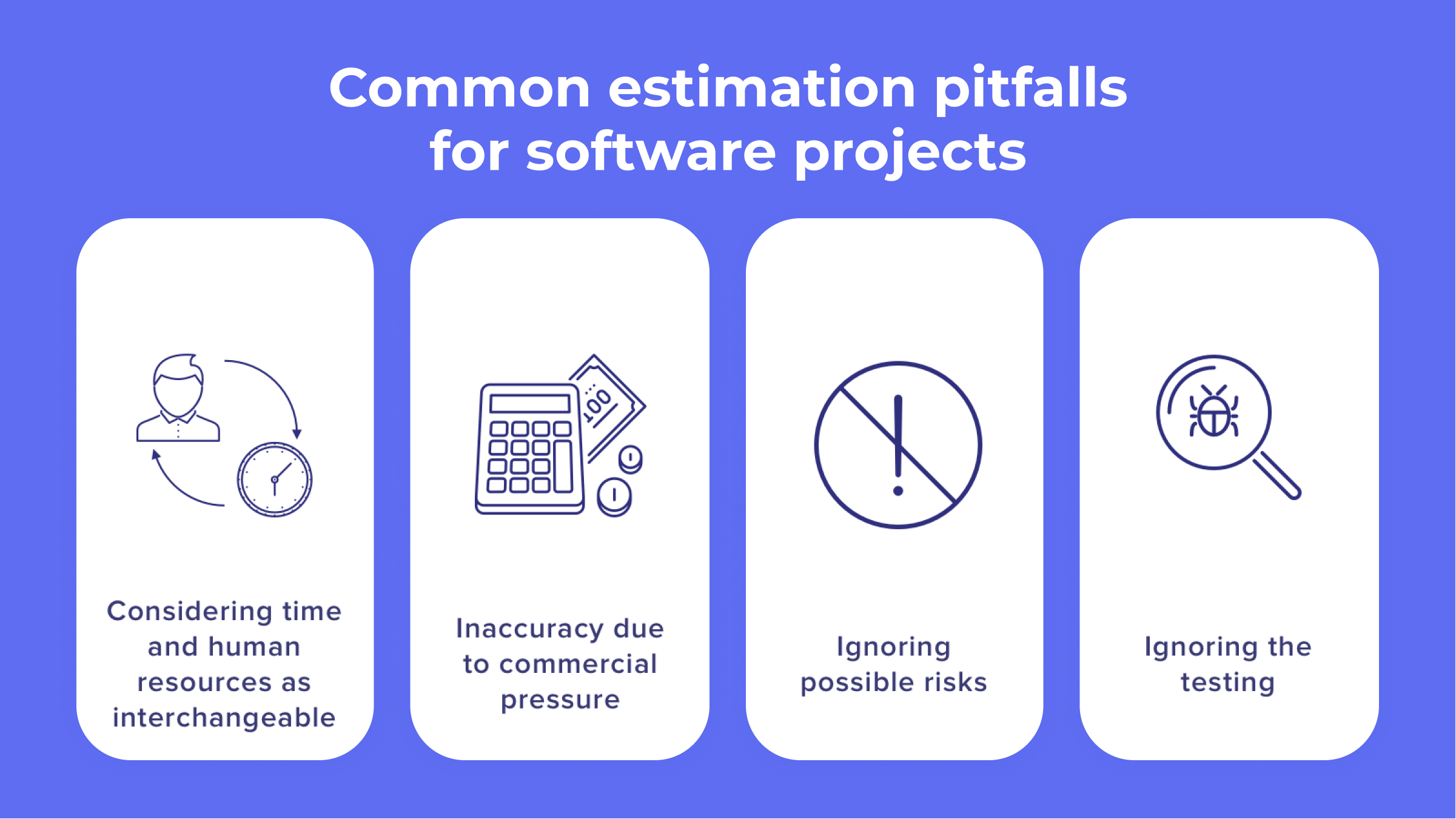Cost software development estimation is vital for the stakeholders. They want to know at least an average price of developing a product to accurately create a project budget summary. Besides, the project’s success often depends on how fast it is delivered within a specific budget.
In this post, we’ll talk about the most popular software project estimation techniques, why conduct estimation in man-hours, and what methods in software engineering do not work.
Why Measure the Project in Man-Hours?
Software development estimation in man-hours enables you to figure out the two things: how much it takes to develop a project and how much money it requires.
But what does man-hour stand for? Put simply, it’s a workload done by an IT specialist during one hour of continual work. The term is divided into two parts:
- Man. The effectiveness depends on specialists’ expertise. For example, junior engineers need much more time to do tasks compared to the senior or middle ones. Thus, the team should consist of different software engineer qualification levels to provide an accurate software development project estimation.
- Hour. Hours imply the process of uninterrupted work. If the task was fulfilled in 2 days, but the actual work time was 3 hours – it’s still 3 hours. In order to reduce downtimes, it’s vital to optimize work schedules in the planning stage.
Both components are essential for obtaining accurate time estimation. For successful planning, all dependencies of tasks and required resources need to be managed. So none of the specialists won’t need to wait for others to complete a related part of the work.
Agile Approach Vs. Traditional Approach: What Is Better for Project Estimation
Conventional project management is based on fixed workload and functionality, and the time and price are changeable. The disadvantages of the traditional approach:
- There is no way to make changes during the project development process.
- Variable cost makes it difficult to manage return on investment (ROI) which leads to unpredictable financial risks.
- Variable time leads to losing control over the product’s strong sides. As a result, your competitors may launch their product earlier or you may miss the important industry date.
The Agile methodology is one of the demand software development methodologies due its flexibility. It implies a fixed amount of team members and project time. So, you can easily make improvements during the development process without affecting the quality. Below you’ll find what makes the Agile approach so beneficial.
- Small work sprints with fixed prices. The project consists of sub-releases, each of which ends with delivering ready-to-use software and has a fixed price. After one sprint finishes, the next one starts with a new estimate considering all the aspects of previous sprints. It allows software developers to predict unplanned costs, add new functionality or revise the old one during the project’s lifecycle.
- Flexibility. This is the core benefit of Agile software project estimation. It means that the programmers are allowed to make any changes to deliver a top-tier product. All you need to do is provide your team with relevant data and a time frame during which the improvements need to be implemented. If the price is the same, there won’t be additional cost for changes. If changes require less money, the extra work will be removed.
- Easy cancellation. If a great part of the project has been released but doesn’t pay off the investments, you may suspend the project. However, it requires long and trustful relationships between clients and IT vendors.
How to Estimate Your Software Project Better
To help you learn about the most effective software project estimation techniques around today, I’ve rounded up the best ones to add to your project management toolbox.
Planning (or Scrum) Poker
This technique implies dividing the project into small parts called sprints (a fixed period of time during which the software engineers need to implement a particular part of the product). Then the Scrum Master holds a meeting with the team to discuss how much time they need to develop certain features. And the most questionable estimations are discussed in daily meetings.
Comparison to the Previous Projects
If the development team already has experience building a similar software project, it’ll be easier to provide an accurate time estimate. During this method, the software developers consider the complexity of the new software and multiply it by required man-hours.
Top-Down & Bottom-Up
The top-down technique means that the project is broken up into certain features, and each of them is estimated individually. After that, the final results are summarized, and you have a clear vision of software development’s required time. And vita versa, the bottom-up method estimates the software project in total. If the project time estimation is significantly different, the Business Analysts define the reason and reach the right balance.
Misconceptions of Software Development Estimation
Now, let’s consider what pitfalls to avoid to come up with an accurate software project estimate.

Time and Human Resources Are Not Interchangeable.
As a team grows, the project delivery time increases since new programmers need extra hours to establish relationships with other team members and get acquainted with the project.
Inaccuracy Due to Commercial Pressure
A vast amount of IT projects estimates are influenced by commercial pressure. On the one hand, sales managers tend to maximize revenue and thus reduce man-hours. On the other hand, they want to deliver a secure software product and try to expand man-hours. The best way is to minimize estimates without reducing scope.
Ignoring Possible Risks
The majority of projects include many coding tasks. That’s why it’s essential to consider the possible risks and provide estimates in “min-max” hours.
Wrapping Up
As you can see, software project estimation is a complex but integral part of the project. However, use the modern software project estimation techniques mentioned above. You’ll be able to provide stakeholders with a precise project estimate and increase the possibility of getting new clients.
Author bio
Kate Orekhova is a tech writer at Cleveroad. A writer by day and a reader at night, she’s keen on technology and innovations. Her passion is to tell people about the latest tech trends in the world of IT.
